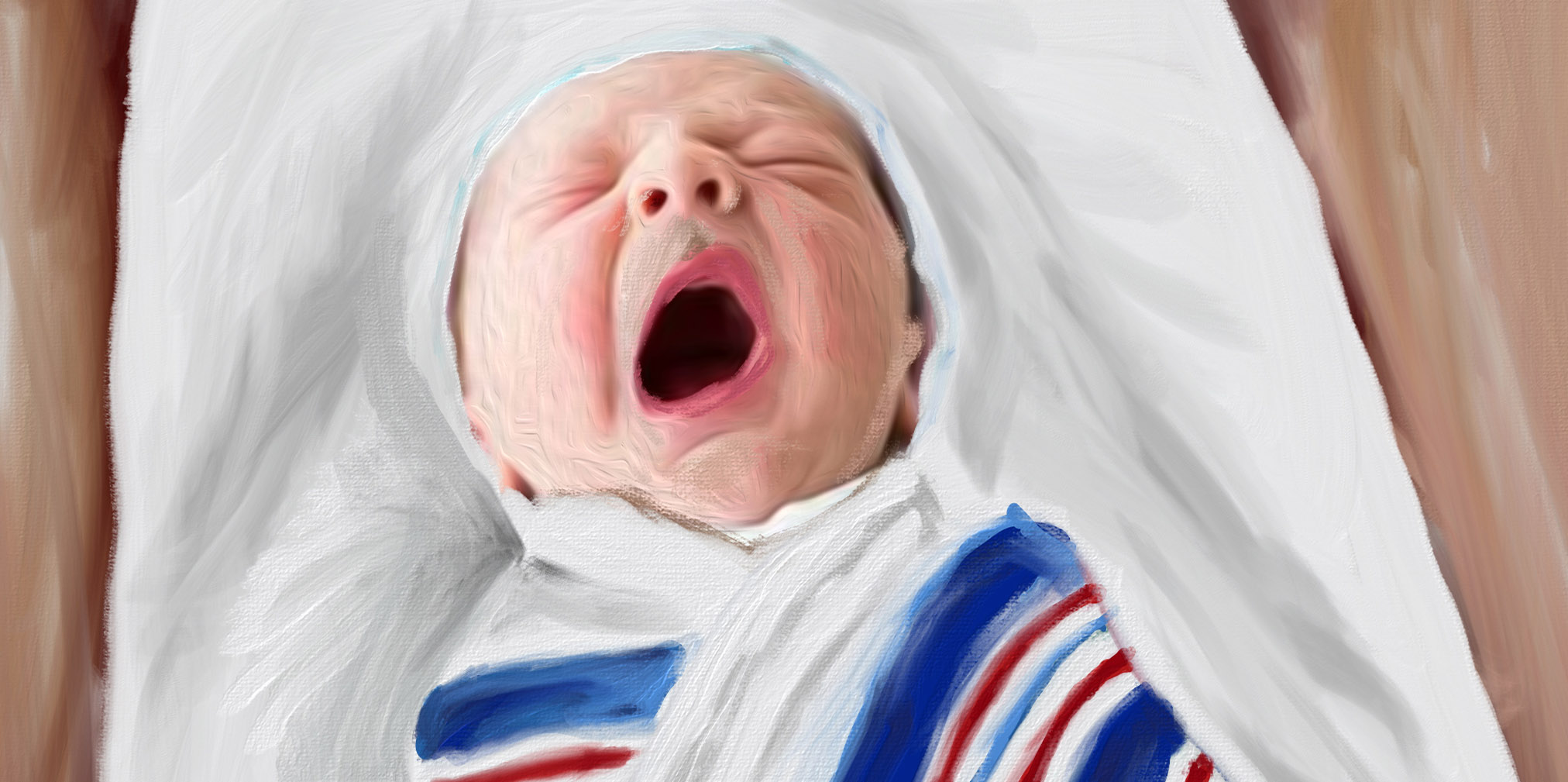Summary
In a bustling maternity ward, an infant has a case of newborn hiccups. But this quickly transforms into labored breathing. A chest X-ray unravels an unexpected discovery — calcium deposits around her shoulder. Follow-up tests paint a complex picture, revealing narrowed blood vessels and widespread calcifications. Genetic testing confirms a grim diagnosis: generalized arterial calcification of infancy, or GACI, a rare genetic condition with a challenging prognosis. Nearly half of infants don’t survive beyond six months. But as Dr. David Weber, a pediatric endocrinologist and the Medical Director for the Center for Bone Health at the Children’s Hospital of Philadelphia, shares, a revolutionary clinical trial could potentially transform this child’s life and the lives of others with this disease.

David Weber
David Weber is a pediatric endocrinologist and bone health specialist in the Division of Pediatric Endocrinology and Diabetes at The Children’s Hospital of Philadelphia and Assistant Professor of Pediatrics at the Perelman School of Medicine at the University of Pennsylvania. He is the medical director for the Center for Bone Health at CHOP, a multi-disciplinary pediatric bone health program caring for patients with genetic and acquired conditions affecting bone health and mineral metabolism. He is an active clinical researcher working on studies in people with primary and secondary skeletal fragility, and rare diseases of bone mineral metabolism.
Transcript
DDx SEASON 10, EPISODE 2
The Power and Potential of GACI Clinical Trials
Dr. Raj Bhardwaj: This episode of DDX was produced in partnership with the American Society for Bone and Mineral Research and sponsored by Inozyme Pharma.
Details of this case have been changed to protect patient privacy.
In a bustling maternity ward, a healthy baby girl is born.
At first, she seems to have a typical case of newborn hiccups.
But this quickly transforms into labored breathing.
A chest X-ray reveals an unexpected finding — calcium deposits around her shoulder.
Follow-up tests paint a complex picture of narrowed blood vessels and widespread calcifications.
Genetic testing confirms a grim diagnosis: generalized arterial calcification of infancy, or GACI, a rare genetic condition with an ominous prognosis — nearly half of infants don’t survive beyond 6 months.
But a revolutionary clinical trial could potentially transform this child’s life and the lives of others with this disease.
This is DDX, a podcast from Figure 1 about how doctors think. I’m Dr. Raj Bhardwaj.
This season is all about the treatment of bone diseases.
Today, a case from Dr. David Weber, a pediatric endocrinologist and the Medical Director for the Center for Bone Health at the Children’s Hospital of Philadelphia.
Dr. Weber is a site principal investigator for several studies funded by Inozyme Pharma, which includes the ENPP1 enzyme replacement therapy referenced in this episode.
Dr. Weber has not been compensated for his participation in this episode and the views presented are his own.
Our patient was diagnosed with generalized arterial calcification of infancy, or GACI, when she was 2-months-old.
Dr. David Weber: She had two different mutations of a gene called ENPP1.
Dr. Bhardwaj: Variations in the ENPP1 or ABCC6 genes, found in different forms of GACI, disrupt the body’s ability to regulate calcium levels.
When these genes malfunction, excess calcium builds up on artery walls, risking stroke or heart attack.
Over time, patients may experience musculoskeletal issues, hearing loss, rickets, high blood pressure, kidney failure, and strokes.
The manifestations of GACI can range from mild to severe.
Dr. Weber: Some patients present with very minimal calcification and very minimal cardiovascular disease. Other patients present with very severe calcification affecting many blood vessels, so that those blood vessels are almost fully blocked, and so the blood can’t flow through them. On the other end of the spectrum, there are some patients who never even have any known cardiovascular complications.
Dr. Bhardwaj: It was impossible to predict how this baby’s form of GACI would unfold.
There’s no cure for GACI, and the standard of care has focused on alleviating symptoms and enhancing quality of life.
Dr. Weber: The standard of care really is going to be just supporting the heart and the lungs. And so that’s going to be things like oxygen, things like breathing tubes and ventilators.
Dr. Bhardwaj: This might include medications to manage high blood pressure, prevent blood clots and reduce the amount of calcium in the blood vessels.
One class of medications prescribed for some GACI patients is bisphosphonates.
Commonly used to treat osteoporosis, bisphosphonates can sometimes prevent calcium buildup in arteries.
Dr. Weber: The family was offered treatment with bisphosphonates, starting shortly after that diagnosis. And they did end up starting on a bisphosphonate called pamidronate, now that was given as an IV infusion once a month.
Dr. Bhardwaj: But even though bisphosphonates are used to treat some GACI patients, the evidence supporting their effectiveness is weak.
Dr. Weber: It’s not known if these medicines actually work … I think it was really because of the uncertainty of whether the bisphosphonates would work and what the future was going to hold. That’s what led the family to be interested in seeking out a clinical trial.
Dr. Bhardwaj: When their little girl was 9-months-old, the family traveled to meet Dr. Weber for the first time.
Dr. Weber: She actually had transferred or come to our center to be evaluated for one of the clinical trials for ENPP1 deficiency.
Dr. Bhardwaj: The trial used ENPP1 enzyme replacement therapy as a treatment for patients with GACI.
Dr. Weber: So it’s essentially a man-made version of the ENPP1 enzyme that is missing in people with GACI. This medicine had been studied in animals as the first step, and had shown some benefits and reducing calcification and improving bone strength and improving blood vessels in mice and was currently being studied in adults.
Dr. Bhardwaj: This study aimed to figure out the correct enzyme dosage for newborns to 12-month-olds and whether there were any safety concerns for this age group.
The previous studies seemed to indicate that the enzyme replacement therapy was both safe and effective.
But despite the potential advantages, Dr. Weber warned the family that participating in a clinical trial wasn’t going to be easy.
Dr. Weber: It’s a huge burden to participate in a clinical trial.
Dr. Bhardwaj: The family would need to relocate to the trial site for six weeks.
Their infant would receive bi-weekly injections and rigorous monitoring during this period.
But the commitment wouldn’t end there; following the initial six weeks, the family would need to travel back to the trial site once a month over the course of a year for continued therapy and close observation.
Dr. Weber: So it’s a huge travel burden on the family. The other thing I always stress is we don’t know if this medicine is going to work. And there’s a chance that there’s side effects that we don’t anticipate. And so I think a big part of what informed the family’s decision to participate is that they wanted to help the community as well and help learn about treatments for these conditions.
Dr. Bhardwaj: The trial was limited to just 14 participants.
After the trial was over, children could remain on the medication with continued monitoring.
Dr. Weber counselled the family on what they might expect.
Dr. Weber: So what I can tell families is, we know from the early information that it does seem to be doing what it’s supposed to do. The patients or the individuals who got those medicines, their levels of the PPi went up into close to the normal range or even in the normal range very quickly after starting. So that tells us that the enzyme is doing what we think it’s supposed to be doing. And so that’s reassuring. For a large part, the experience has been that the medicine has been safe. And then from that, it’s really been almost speculation.
And so what I can tell people is look, the problem of this condition is that when you have low levels of the PPi in the blood, that leads to the calcium forming where you don’t want it to form, that leads to the development of rickets. And what we know from the animal studies show that when you can raise up those levels of the PPi, that we’ll have less of those negative effects. So that’s what I’m really telling people. But I can’t guarantee it because we just don’t have enough information yet.
Dr. Bhardwaj: Engaging in a clinical trial offers a clear advantage — access to drugs not yet available to the public.
For patients grappling with GACI, this opportunity has the potential to be truly transformative.
So far, our patient has been in the study for nine months.
Dr. Weber: I don’t have access to all the study outcome data that they’re looking at. I can tell you she tolerated the injections quite well, so she’s had no significant side effects at all, tolerating the infusions fine.
I think she’s doing well. When I see her every month, she’s getting bigger, she’s getting stronger. And in a lot of ways, she’s developing like I would expect any other toddler to be developing. And so I think that’s very reassuring.
Dr. Bhardwaj: Enzyme replacement therapy could represent a groundbreaking shift from the current standard of care for GACI patients.
Dr. Weber: I think in an ideal world, this is the perfect drug because it is the, we are replacing what is missing. So we’re replacing the ENPP1 enzyme. As of right now, what we do is, we’re just doing our best to treat the complications of this disease. What we would be doing here is really treating the disease itself. So that would be a revolutionary treatment.
Dr. Bhardwaj: Now, let’s delve into the central insights from this case …
Dr. Weber: The biggest lesson is, you know, you have to always be on the lookout for these rare diseases. Generally speaking for GACI, is that the earlier the diagnosis, like the better. One, one thing that we’ve learned about rare diseases. I think a good example is hypophosphatasia, before there was a treatment for it, I think we thought that it was much more rare than it actually has turned out to be. And so I think when you start looking for rare diseases, it turns out that they’re more common than you think.
Dr. Bhardwaj: And ENPP1 enzyme replacement therapy has the potential to treat a wide range of patients who suffer from other forms of calcifications.
Dr. Weber: There’s all sorts of people who develop vascular and other calcifications for all sorts of other reasons. Some of them are genetic. Some of them happen later on in life. That’s not uncommon for patients with chronic kidney disease to develop calcification in blood vessels and other places. And so it is certainly possible that if this therapy is shown to be effective in raising PPi levels and preventing calcifications and GACI, that it certainly might have a role in some of these other conditions where calcifications can develop and be problematic.
Dr. Bhardwaj: Thanks to Dr. Weber for speaking with us.
This is DDX, a podcast by Figure 1. Figure 1 is an app that lets doctors share clinical images and knowledge about difficult-to-diagnose cases.
I’m Dr. Raj Bhardwaj, host and story editor of DDX.
Head over to figure1.com/ddx where you can find full show notes, speaker bios and photos.
This episode of DDX was produced in partnership with the American Society for Bone and Mineral Research and sponsored by Inozyme Pharma.
Thanks for listening!





